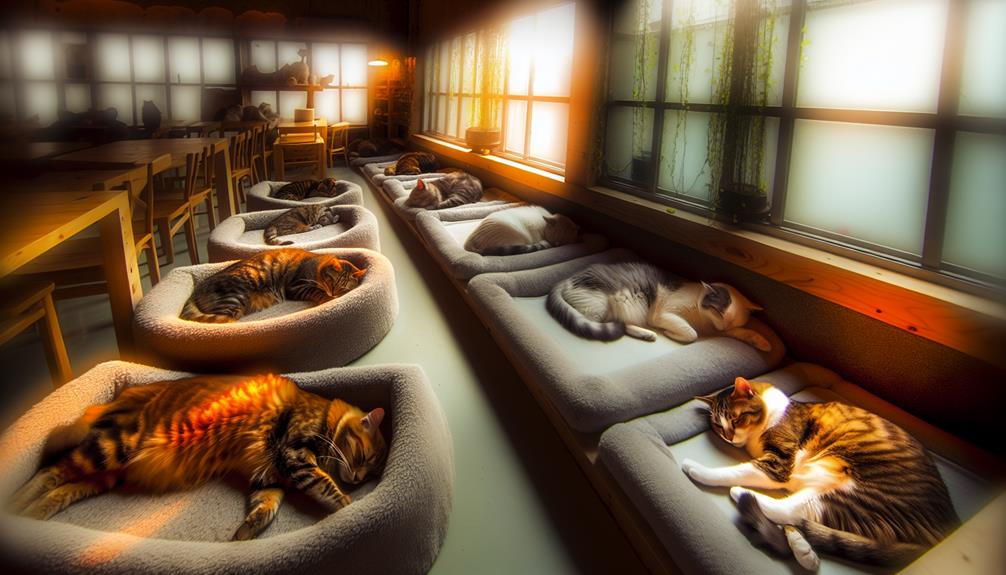Imagine your cat, Whiskers, curled up on the windowsill, dozing peacefully for what seems like hours on end. You've probably heard that cats spend around 75% of their lives sleeping, but have you ever wondered why? This extensive sleep isn't just laziness; it's essential for their survival and well-being. From evolutionary adaptations to health benefits, there are several compelling reasons behind their prolonged slumber. Curious about how your cat's age, environment, and even potential sleep disorders play a role in this behavior? Let's explore the fascinating world of feline sleep patterns and uncover what lies beneath those sleepy eyes.
Evolutionary Reasons
When examining the evolutionary reasons behind feline characteristics, it is crucial to understand how their traits have been shaped over millions of years for survival. Cats, as obligate carnivores, have developed specific adaptations to enhance their predatory instincts. These instincts are critical for locating, stalking, and capturing prey. Their retractable claws, keen eyesight, and acute hearing are all evolutionary traits that contribute to their efficiency as hunters. You'll notice that these physical characteristics are optimized for a solitary hunting lifestyle, ensuring that each hunt is as successful as possible.
Energy conservation is another key factor in the evolutionary development of cats. Unlike many animals that graze or forage throughout the day, cats have evolved to expend significant bursts of energy in short periods. This is evident in their hunting behavior, where they stalk and then pounce on their prey. To support these high-energy activities, cats need to conserve energy whenever they're not actively hunting. This explains why you often see cats lounging or resting for extended periods. Their bodies are designed to minimize unnecessary energy expenditure, allowing them to be ready for sudden, intense activity.
Moreover, their metabolic rate is adapted to this lifestyle. Cats have a high protein diet, which provides them with the necessary energy for their predatory activities. This dietary need has further influenced their behavior and physical traits, ensuring they remain efficient hunters. Understanding these evolutionary reasons gives you a clearer picture of why cats behave the way they do and highlights the intricate balance between predatory instincts and energy conservation that defines their existence.
Sleep Cycles
Observing the sleep cycles of cats reveals fascinating insights into their biology and behavior. Cats exhibit polyphasic sleep patterns, characterized by multiple sleep-wake cycles throughout the day. Unlike humans, who typically experience monophasic sleep, cats distribute their rest into several short periods.
A typical cat's sleep cycle includes both non-REM (NREM) and REM sleep phases. NREM sleep accounts for approximately 70% of a cat's total sleep time and is subdivided into light and deep sleep stages. During NREM sleep, cats engage in restorative processes such as tissue repair and immune function enhancement.
REM sleep, making up roughly 30% of a cat's sleep cycle, is essential for cognitive functions like memory consolidation and learning. You might notice your cat twitching or moving its paws during REM sleep, indicating dream activity.
The duration of a cat's naps varies considerably, ranging from brief 15-minute snoozes to longer, more substantial rest periods lasting up to several hours. These naps allow cats to remain vigilant and responsive to environmental stimuli, an evolutionary trait beneficial for hunting and predator avoidance.
Here are some key points about cat sleep cycles:
- Polyphasic Sleep: Cats sleep multiple times a day, unlike humans' single, long sleep period.
- NREM Sleep: Constitutes 70% of a cat's sleep, critical for physical restoration.
- REM Sleep: Comprises 30% of their sleep, fundamental for mental processes.
- Nap Duration: Varies between 15 minutes to several hours, promoting alertness.
- Dream Activity: Evident during REM sleep, indicating complex brain functions.
Understanding these sleep cycles helps you appreciate the intricate balance cats maintain between rest and alertness, essential for their survival and overall well-being.
Health Benefits

Understanding a cat's sleep cycles not only reveals aspects of their behavior but also underscores the significant health benefits they derive from their unique rest patterns. A cat's ability to spend up to 75% of its life sleeping is essential for stress reduction. Extended sleep periods allow their bodies and minds to recover from daily activities, which can lower cortisol levels and reduce overall stress.
Moreover, sleep is important for immune support. During deep sleep, a cat's body undergoes repair and regeneration processes, bolstering its immune system. This restorative phase is critical for maintaining a strong defense against infections and diseases, ensuring overall wellness.
Mental health is another beneficiary of a cat's sleep habits. Adequate sleep helps in memory consolidation and cognitive function. Cats process and store information gathered throughout the day during their sleep, enhancing their learning and problem-solving abilities. This cognitive function is crucial for their survival instincts, hunting skills, and social interactions.
Energy conservation is a fundamental aspect of a cat's extensive sleep schedule. By sleeping for prolonged periods, cats conserve energy required for hunting and other high-energy activities. This energy conservation is especially significant for wild and feral cats, but it also benefits domestic cats by keeping them agile and responsive.
Age and Sleeping Patterns
Cats' sleep patterns evolve considerably as they age. You'll notice significant differences in sleep behaviors from the kitten stage through to their senior years. Understanding these changes can help you guarantee your feline friend gets the rest they need at every life stage.
In the kitten phase, sleep is essential for development. Kittens can sleep up to 20 hours a day. This extended rest period supports their rapid growth and neurological development. Kitten sleep is often segmented into short bursts of intense activity followed by long naps.
As cats shift to adulthood, their sleep requirements decrease slightly, averaging around 12-16 hours per day. Adult cats tend to have more structured sleep patterns, often aligning their periods of wakefulness with human activity. They engage in more REM sleep, which is critical for cognitive functions and overall health.
When cats reach their senior years, sleep patterns shift again. Senior sleep often increases in duration, sometimes resembling the extensive sleep patterns seen in kittens. However, the quality of sleep may decline due to health issues like arthritis or cognitive dysfunction.
It's important to observe and adapt to these changing patterns for your cat's well-being. Here are some key points to reflect on:
- Kitten Sleep: Essential for growth and development.
- Adult Sleep: More structured, reduced duration.
- Senior Sleep: Increased duration, potentially lower quality.
- REM Sleep: Critical across all life stages for cognitive health.
- Health Monitoring: Adjustments may be needed based on health changes.
Environmental Factors

Recognizing the sleep patterns of your cat at various life stages is just one part of ensuring their overall health and well-being. Another essential aspect involves optimizing their sleep environment. Research indicates that environmental factors like light exposure, noise levels, and temperature preferences greatly affect feline sleep quality and duration.
First, consider the impact of light exposure. Cats are crepuscular, meaning they are most active during dawn and dusk. Hence, controlling light levels in their resting spots can help regulate their sleep cycles. Use dim lighting or blackout curtains to simulate a natural sleep environment, promoting better rest.
Noise levels also play a pivotal role in your cat's sleep. Cats have highly sensitive hearing and can be easily disturbed by loud or sudden noises. Providing a quiet, serene space away from household commotion can enhance their sleep quality. In multi-pet households, isolation from other animals during sleep times may also be beneficial.
Temperature preferences are another vital factor. Cats tend to seek out warm spots as they have a higher body temperature than humans. Ensuring their resting spots are neither too hot nor too cold is essential. Use heating pads or cozy blankets to create a comfortable sleeping area, especially in cooler climates.
Signs of Sleep Disorders
Detecting sleep disorders in cats can be challenging yet vital for their health. Just like in humans, disruptions in sleep can greatly impact a cat's overall well-being. Understanding the signs of sleep disorders such as feline insomnia or sleep deprivation requires careful observation of cat behavior and napping habits.
First, pay attention to changes in napping habits. If your cat, typically a sound sleeper, starts experiencing restless nights or frequent awakenings, this could indicate an underlying issue. Next, observe if there's an increase in daytime lethargy. A cat suffering from sleep deprivation may appear unusually tired during the day.
Signs of Sleep Disorders:
- Erratic sleep patterns: Cats with sleep disorders may show irregular sleep cycles, alternating between extended naps and periods of restlessness.
- Nighttime activity: Increased activity during nocturnal hours can be a sign of insomnia. If your cat is frequently awake and active at night, it may be struggling with sleep.
- Vocalization: Increased meowing or crying at night can indicate discomfort or anxiety, contributing to disrupted sleep.
- Changes in appetite: Sleep-deprived cats might exhibit changes in their eating habits, either a decrease or an increase in appetite.
- Altered behavior: Unusual aggression, irritability, or withdrawal can be a response to disturbed sleep.
Additionally, consider the sleep environment. Make sure it's conducive to restful sleep, free from disturbances and comfortably set up. If you suspect your cat has a sleep disorder, consulting a veterinarian for an evaluation and possible treatment options is critical. Identifying and addressing these signs early can help maintain your cat's health and quality of life.
Conclusion
In principle, cats spend a remarkable 75% of their lives sleeping, a behavior that's vital for their overall health. Imagine a senior cat named Whiskers, who, despite her age, remains agile and alert due to her consistent 16-hour daily sleep routine. This extensive rest supports her cognitive function, immune health, and stress reduction. Understanding these sleep patterns can help you guarantee your cat enjoys a healthy, balanced life, free from sleep disorders.
